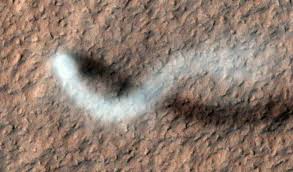Recent studies have confirmed the widespread presence of powerful dust devils on Mars, providing new insights into how these miniature whirlwinds shape the planet’s atmosphere, surface, and weather systems.
Researchers analyzing data from NASA’s Perseverance rover and the Mars Reconnaissance Orbiter (MRO) have documented hundreds of these spinning columns of dust — some stretching several kilometers high. The findings reveal that Mars’ near-surface winds are far stronger and more dynamic than previously believed, influencing its overall climate and surface evolution.
Dynamic Winds in Thin Martian Air
Dust devils occur when sunlight heats the ground, causing warm air to rise and twist into a rotating vortex. On Earth, they are usually small and short-lived, but on Mars — where the atmosphere is just 1% as dense — they can grow massive, long-lasting, and capable of lifting dust high into the sky.
Scientists suggest these vortices play a crucial role in redistributing dust across the Martian surface and may even contribute to planet-wide dust storms that can last for weeks.
A Window into Martian Weather
Perseverance’s instruments have recorded pressure drops and visible dust movements consistent with intense, fast-moving vortices. These observations are helping researchers refine Martian weather models, essential for predicting wind patterns that affect spacecraft and surface operations.
Interestingly, dust devils also act as natural cleaners for solar-powered equipment. The InSight lander and several earlier Mars rovers experienced boosts in power after passing whirlwinds blew dust off their solar panels.
Implications for Future Exploration
As NASA and ESA gear up for new robotic and human missions to Mars, understanding the planet’s wind dynamics is becoming increasingly critical. These findings may influence spacecraft design, surface operations, and even energy management for future habitats.
While they may seem chaotic, Mars’ dust devils could hold vital clues to how its thin atmosphere behaves — and how it has evolved over time. Studying them offers a window into the Red Planet’s past climate and its ongoing geophysical transformations.

